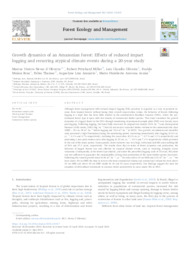Growth dynamics of an Amazonian forest: Effects of reduced impact logging and recurring atypical climate events during a 20-year study.
Growth dynamics of an Amazonian forest: Effects of reduced impact logging and recurring atypical climate events during a 20-year study.
Author(s): OLIVEIRA, M. V. N. d'; MILLER, R. P.; OLIVEIRA, L. C. de; BRAZ, E. M.; THAINES, F.; JANUÁRIO, J. L.; ACUÑA, M. H. A.
Summary: Although forest management with reduced impact logging (RIL) practices is regarded as a way to generate in- come from tropical forests without losing their overall conservation values, the behavior of forests following logging is a topic that has been little studied in the southwestern Brazilian Amazon (SWA), where the pre- dominant forest type is open with low density of commercial timber species. This study examined the growth dynamics of a logged forest in the SWA through monitoring of permanent sample plots (PSP) over twenty years post logging. Following logging, the forest fully recovered its original tree density (439. ha 1) and aboveground biomass (AGB) stocks (188.4 Mg. ha 1) but did not recover extracted timber volume in the commercial size class (DBH > 50 cm, 28 m3. ha 1 before logging and 22.6 m3. ha 1 in 2022). Tree growth, recruitment and mortality rates presented a high fluctuation during the monitoring period, increasing immediately after logging (0.43 cm. yr. 1, 4.1 % and 4.7 % respectively), declining five years after, (0.25 cm. yr. 1, 0.7 % and 1.5 % respectively) and presenting a new peak sixteen years after logging (0.35 cm. yr. 1, 3.9 % and 7.4 % respectively) which persisted to the end of the study period. Consequently, forest turnover was very high, with stand half-life and doubling life of 29.6 and 27.2 years, respectively. The results show that in terms of forest dynamics and production, the behavior of logged forests was also affected by atypical climate events, such as recurring droughts across Amazonia. Consequently, in the forest type studied, and under the prescribed logging cycle of 25 years, RIL alone was not sufficient to guarantee the sustainability of long-term production of the main timber species harvested. Following the current growth trend (0.46 m3. ha 1. yr. 1 for trees above 10 cm DBH and 0.22 m3. ha 1. yr. 1 for trees above 50 cm DBH) the time to recover the total commercial volume and commercial volume for trees above 10 cm DBH and above 50 cm DBH would be 34 and 45 years respectively. Our findings suggest the need for adoption of silvicultural treatments to increase forest productivity in areas under RIL in SWA.
Publication year: 2024
Types of publication: Journal article
Unit: Embrapa Acre
Observation
Some of Embrapa's publications are published as ePub files. To read them, use or download one of the following free software options to your computer or mobile device. Android: Google Play Books; IOS: iBooks; Windows and Linux: Calibre.
Access other publications
Access the Agricultural Research Database (BDPA) to consult Embrapa's full library collection and records.
Visit Embrapa Bookstore to purchase books and other publications sold by Embrapa.

